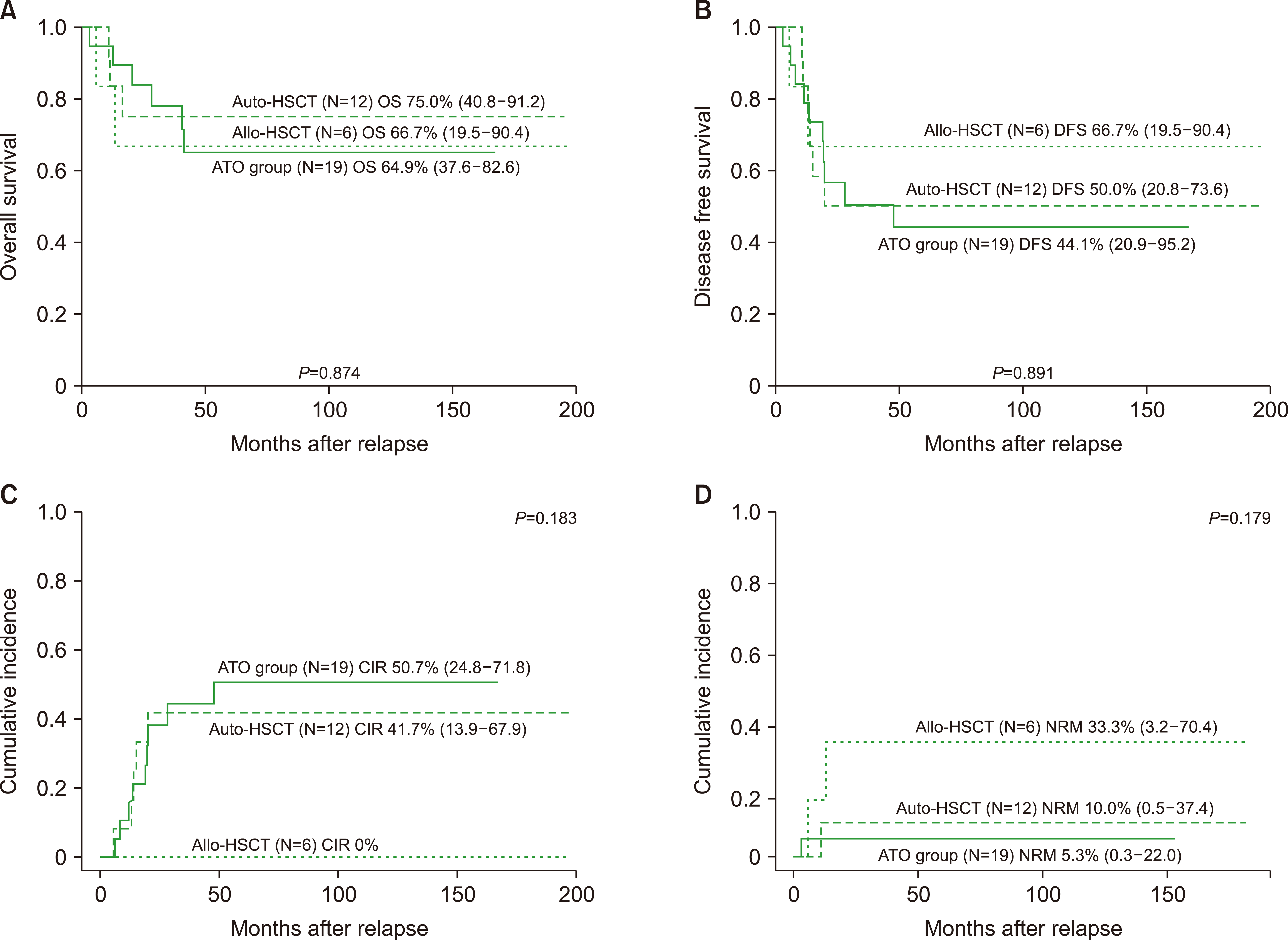1. Sanz MA, Grimwade D, Tallman MS, et al. 2009; Management of acute promyelocytic leukemia: recommendations from an expert panel on behalf of the European LeukemiaNet. Blood. 113:1875–91. DOI:
10.1182/blood-2008-04-150250. PMID:
18812465.

2. Soignet SL, Frankel SR, Douer D, et al. 2001; United States multicenter study of arsenic trioxide in relapsed acute promyelocytic leukemia. J Clin Oncol. 19:3852–60. DOI:
10.1200/JCO.2001.19.18.3852. PMID:
11559723.

3. Park JH, Qiao B, Panageas KS, et al. 2011; Early death rate in acute promyelocytic leukemia remains high despite all-trans retinoic acid. Blood. 118:1248–54. DOI:
10.1182/blood-2011-04-346437. PMID:
21653939. PMCID:
PMC3790946.

4. Lengfelder E, Lo-Coco F, Ades L, et al. 2015; Arsenic trioxide-based therapy of relapsed acute promyelocytic leukemia: registry results from the European LeukemiaNet. Leukemia. 29:1084–91. DOI:
10.1038/leu.2015.12. PMID:
25627637.

6. Yanada M, Tsuzuki M, Fujita H, et al. 2013; Phase 2 study of arsenic trioxide followed by autologous hematopoietic cell transplantation for relapsed acute promyelocytic leukemia. Blood. 121:3095–102. DOI:
10.1182/blood-2012-11-466862. PMID:
23412094.

7. Holter Chakrabarty JL, Rubinger M, Le-Rademacher J, et al. 2014; Autologous is superior to allogeneic hematopoietic cell trans-plantation for acute promyelocytic leukemia in second complete remission. Biol Blood Marrow Transplant. 20:1021–5. DOI:
10.1016/j.bbmt.2014.03.025. PMID:
24691221. PMCID:
PMC4097890.

8. Sanz J, Labopin M, Sanz MA, et al. 2021; Hematopoietic stem cell transplantation for adults with relapsed acute promyelocytic leukemia in second complete remission. Bone Marrow Transplant. 56:1272–80. DOI:
10.1038/s41409-020-01162-0. PMID:
33323947.

9. Breccia M, Cicconi L, Minotti C, Latagliata R, Giannì L, Lo-Coco F. 2011; Efficacy of prolonged therapy with combined arsenic trioxide and ATRA for relapse of acute promyelocytic leukemia. Haematologica. 96:1390–1. DOI:
10.3324/haematol.2011.045500. PMID:
21659361. PMCID:
PMC3166113.

10. Aribi A, Kantarjian HM, Estey EH, et al. 2007; Combination therapy with arsenic trioxide, all-trans retinoic acid, and gemtuzumab ozogamicin in recurrent acute promyelocytic leukemia. Cancer. 109:1355–9. DOI:
10.1002/cncr.22524. PMID:
17326049.

11. Lee S, Kim YJ, Eom KS, et al. 2006; The significance of minimal residual disease kinetics in adults with newly diagnosed PML-RARalpha- positive acute promyelocytic leukemia: results of a prospective trial. Haematologica. 91:671–4. PMID:
16627255.
13. Sanz MA, Lo Coco F, Martín G, et al. 2000; Definition of relapse risk and role of nonanthracycline drugs for consolidation in patients with acute promyelocytic leukemia: a joint study of the PETHEMA and GIMEMA cooperative groups. Blood. 96:1247–53. PMID:
10942364.
14. Douer D, Zickl L, Schiffer CA, et al. 2011; Late relapses following all-trans retinoic acid for acute promyelocytic leukemia are uncommon, respond well to salvage therapy and occur inde-pendently of prognostic factors at diagnosis: long-term follow-up of north american intergroup study I0129. Blood (ASH Annual Meeting Abstracts). 118(Suppl):83. DOI:
10.1182/blood.V118.21.83.83.

15. Lo-Coco F, Cicconi L, Breccia M. 2016; Current standard treatment of adult acute promyelocytic leukaemia. Br J Haematol. 172:841–54. DOI:
10.1111/bjh.13890. PMID:
26687281.

16. Raffoux E, Rousselot P, Poupon J, et al. 2003; Combined treatment with arsenic trioxide and all-trans-retinoic acid in patients with relapsed acute promyelocytic leukemia. J Clin Oncol. 21:2326–34. DOI:
10.1200/JCO.2003.01.149. PMID:
12805334.

17. Shen ZX, Chen GQ, Ni JH, et al. 1997; Use of arsenic trioxide (As2O3) in the treatment of acute promyelocytic leukemia (APL): II. Clinical efficacy and pharmacokinetics in relapsed patients. Blood. 89:3354–60. DOI:
10.1182/blood.V89.9.3354. PMID:
9129042.
19. Fouzia NA, Sharma V, Ganesan S, et al. 2021; Management of relapse in acute promyelocytic leukaemia treated with up-front arsenic trioxide-based regimens. Br J Haematol. 192:292–9. DOI:
10.1111/bjh.17221. PMID:
33216980. PMCID:
PMC7894296.

20. Ganzel C, Mathews V, Alimoghaddam K, et al. 2016; Autologous transplant remains the preferred therapy for relapsed APL in CR2. Bone Marrow Transplant. 51:1180–3. DOI:
10.1038/bmt.2016.96. PMID:
27088379. PMCID:
PMC5014591.

21. Thirugnanam R, George B, Chendamarai E, et al. 2009; Comparison of clinical outcomes of patients with relapsed acute promyelocytic leukemia induced with arsenic trioxide and consolidated with either an autologous stem cell transplant or an arsenic trioxide- based regimen. Biol Blood Marrow Transplant. 15:1479–84. DOI:
10.1016/j.bbmt.2009.07.010. PMID:
19822309.
22. Fujita H, Asou N, Iwanaga M, et al. 2013; Role of hematopoietic stem cell transplantation for relapsed acute promyelocytic leukemia: a retrospective analysis of JALSG-APL97. Cancer Sci. 104:1339–45. DOI:
10.1111/cas.12230. PMID:
23837667. PMCID:
PMC7656542.

23. de Botton S, Fawaz A, Chevret S, et al. 2005; Autologous and allogeneic stem-cell transplantation as salvage treatment of acute promyelocytic leukemia initially treated with all-trans-retinoic acid: a retro-spective analysis of the European acute promyelocytic leukemia group. J Clin Oncol. 23:120–6. DOI:
10.1200/JCO.2005.03.127. PMID:
15534358.






 PDF
PDF Citation
Citation Print
Print


 XML Download
XML Download